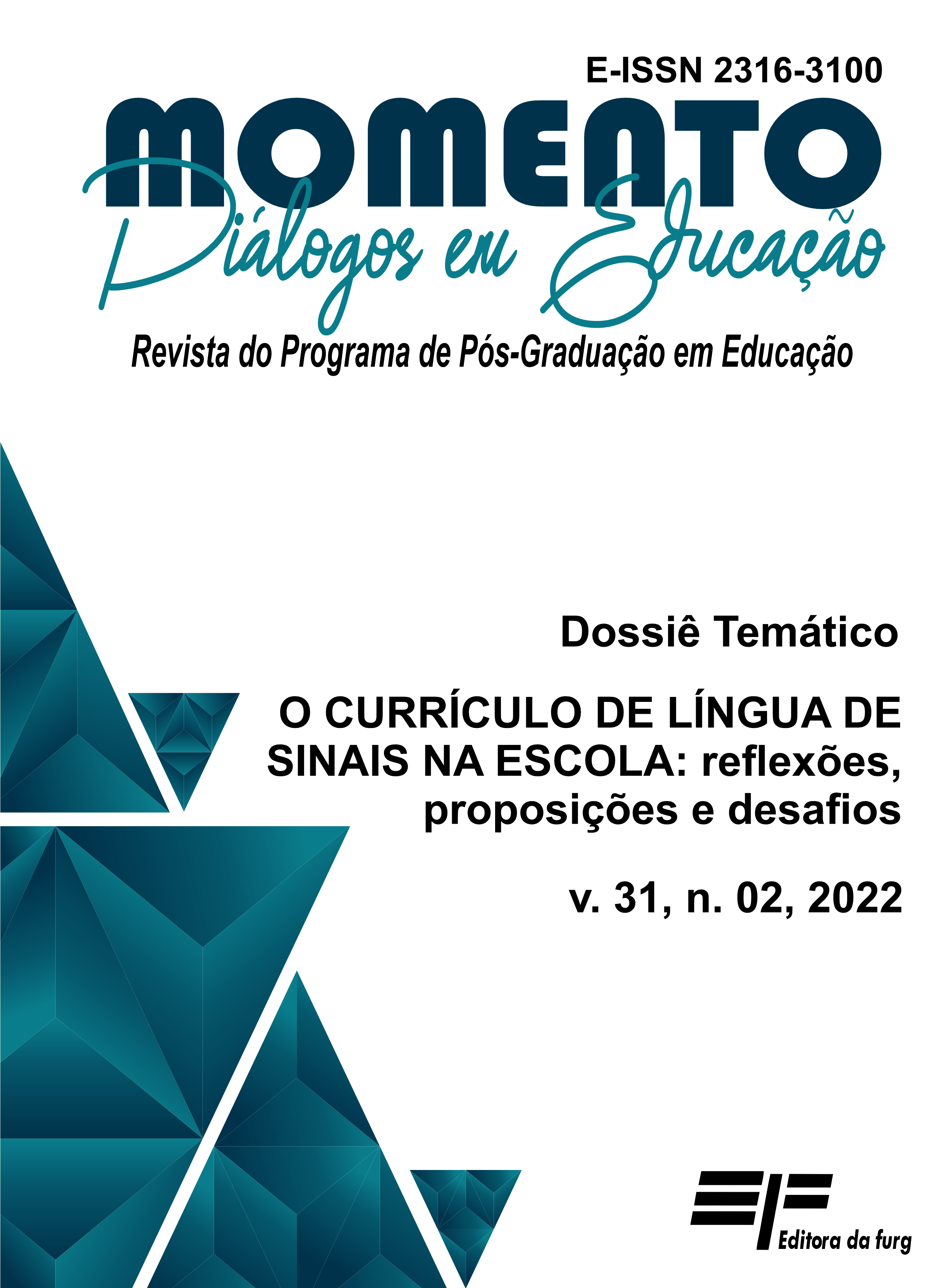THE PORTUGUESE SIGN LANGUAGE CURRICULUM
past, present and future
DOI:
https://doi.org/10.14295/momento.v31i02.14189Keywords:
Deaf Education. Bilingual Education. Portuguese Sign Language. Educational Policies. Curriculum Program.Abstract
The Portuguese Sign Language (hereinafter LGP) is linked to deaf education in Portugal for decades. Its genesis can be found in the first institutes in Lisbon and Porto in the 19th century, in which a considerable number of deaf children and young people had gathered and developed signed communication systems. During the 19th century, the methodologies used in deaf education were based on signed systems and the manual alphabet. With the advent of oralist methodologies introduced in Portugal, these signed communication systems were banned from the classroom, although deaf students continued to develop their sign communication clandestinely. The LGP was only rescued in the 80s and 90s of the 20th century as a result of the studies carried out by the University of Lisbon in partnership with the Portuguese Association of the Deaf, and of the first attempts to implement bilingual education for deaf students, which resulted in the need to teach LGP as a first language to deaf students and the construction of an LGP curriculum. Only with the publication of the Decree-Law 3/2008, which regulates bilingual education for deaf students for the first time in its Article 23, the first national LGP curriculum is published (DGIDC, 2008). In 2018, two new Decree-Laws (54/2018 and 55/2018) were published that revoke the previous Decree-Law and promote a curriculum review of all school subjects. In order to understand the effectiveness of the 2008 LGP curriculum, we carried out an exploratory study. We interviewed four deaf LGP teachers, whose results point to a proposal to reformulate the LGP curriculum, respecting the legislation published in 2018 and meeting the reality of the current deaf school population.
Downloads
References
Pe AGUILAR, Pedro Maria de. Instrução e Educação dos Surdos-Mudos (21-30). Lisboa: Empresa de Lucas Evangelista Torres, Biblioteca Nacional de Portugal, 1893.
AMARAL, M.A.; COUTINHO, A.; DELGADO-MARTINS, M.R. Para uma Gramática da Língua Gestual Portuguesa. Lisboa: Ed. Caminho, 1994.
ALVES, M.C. Educação Especial e Modernização Escolar: Estudo Histórico-Pedagógico da Educação de Surdos-Mudos e Cegos. Dissertação de Doutoramento, Instituto de Educação, Universidade de Lisboa, Lisboa, 2012.
AR. Lei Constitucional no1/97 de 20 de Setembro. Diário da República, Iª Série – A, no 218. INCM, 1997.
BIKLEN, S.K.; BOGDAN, R.C. Investigação qualitativa na educação. Porto: Porto Editora, 1994.
BONNAL-VERGÊS, F. Langue des Signes Française (LSF): des lexiques des XVIII et XIX siécle. In: Sabria, Richard (Ed.). Les Langues des signes (LS): recherches sociolinguistiques et linguistique. Glottopol, Université de Rouen - Laboratoire Dylis, 2006, p. 160-190. Disponível em: . Acesso em: Maio 10 de 2010.
CARVALHO, P. Breve História dos Surdos no Mundo e em Portugal. Lisboa: Ed. Surd’universo, 2007.
CARVALHO, P. A Educação de Surdos na Casa Pia: Resenha histórica. Lisboa: Ed. Casa Pia de Lisboa/ Althum.com, 2019.
CANON, J.; GUARDINO, C.; GALIMORE, E. A New Kind of Heterogenity: What we can learn from d/Deaf and hard of hearing multilingual learners. American Annals of the Deaf, vol. 161, n. 1, p. 8-16, 2016.
CLARK, T. The assessment and development of deaf children with multiple challenges. In: KNOORS, H.; MARSCHARCK, M. (Eds.) Evidence-Based Pratice in Deaf Education. Oxford University Press, 2018.
CUNHA, J.C. História do Instituto dos Surdos-Mudos e Cegos de Lisboa, desde a sua Fundação à sua incorporação na Casa Pia de Lisboa. Lisboa, 1835.
DA COSTA, A. No Minho. Lisboa: Imprensa Nacional, 1874.
FUSSILIER, A. Esboço histórico do ensino dos surdos-mudos em Portugal. Estudo apresentado ao Congresso pedagógico hispano-português-americano realisado em Madrid em Outubro de 1892.
GIL, A. Como elaborar projetos de pesquisa. 4a Ed. Sao Paulo: Atlas, 2008.
GREGORY, S. Sign Language and education of deaf pupils. Disponível em: <https://www.batod.org.uk/information/sign-language-and-the-education-of-deaf-pupils/>. British Association of Teachers of the Deaf, 2017. Acesso em: 16 de Setembro de 2021.
KNOORS, H.; MARSCHARCK, M. (Eds.). Evidence-Based Pratice in Deaf Education. Oxford University Press, 2018.
LOURENÇO, A.J. Breve Resumo Histórico da Educação de Surdos em Portugal. Revista A Criança Surda, n. 3, p.76-102, 1956.
MARZANO, R.J. Building background knowledge for academic achievement. Alexandria, VA: ASCD, 2004.
MAY, T. Pesquisa social: questões, métodos e processos. Porto Alegre: Artmed, 2004.
MERTZANI, M. Learning materials for Greek Sign Language as a First Language. Revista Espaço Ines, v. 45, p. 111-131, 2016.
MINISTÉRIO DA EDUCAÇÃO/ Direção Geral de Inovação e Desenvolvimento Curricular (ME/ DGIDC), Programa Curricular de Língua Gestual Portuguesa. Lisboa, 2007.
MINISTÉRIO DA EDUCAÇÃO. Decreto-Lei 3/2008, de 7 de Janeiro. Diário da República, I Série, n. 4. Lisboa: INCM, 2008, p. 154-164.
MINISTÉRIO DA EDUCAÇÃO. Decreto-Lei n.º 54/2018, de 6 de julho. Diário da República n.129, Série 1. Lisboa: INCM, 2018.
MINISTÉRIO DO REINO. Diário das Cortes Gerais e Extraordinárias da Nação Portugueza, 1822.
MITCHELL, R.E.; KARCHMER, M.A. When Parents Are Deaf Versus Hard of Hearing: Patterns of Sign Use and School Placement of Deaf and Hard-of-Hearing Children. The Journal of Deaf Studies and Deaf Education, vol. 9, n. 2, p. 133–152, 2004.
PINHO E MELO, A.; MORENO, C.; AMARAL, I.M.; SILVA, M.L.D.; DELGADO-MARTINS, M.R. A criança deficiente auditiva: situação educativa em Portugal. Lisboa: Fundação Calouste Gulbenkian, 1984.
PRATA, M.I. Mãos que falam. Lisboa: D.G.E.B, 1980.
RICHARDSON, R. Pesquisa Social: métodos e técnicas. Sao Paulo: Atlas, 1999.
SANTOS, A. O ensino dos Surdos-Mudos em Portugal. Lisboa: Tipografia Casa Portuguesa, 1913.
SELLTIZ, W. Métodos de pesquisa nas relações sociais. Sao Paulo: EPU, 1987.
UNESCO. Declaração de Salamanca e o Enquadramento da Acção – Necessidades Educativas Especiais. Adaptado pela Conferência Mundial sobre Necessidades Educativas Especiais: Acesso e Qualidade. Salamanca, 1994.
Downloads
Published
How to Cite
Issue
Section
License
Copyright (c) 2022 Momento - Diálogos em Educação

This work is licensed under a Creative Commons Attribution 4.0 International License.
À Revista Momento − Diálogos em Educação, ficam reservados os direitos autorais, de todos os artigos nela publicados.


